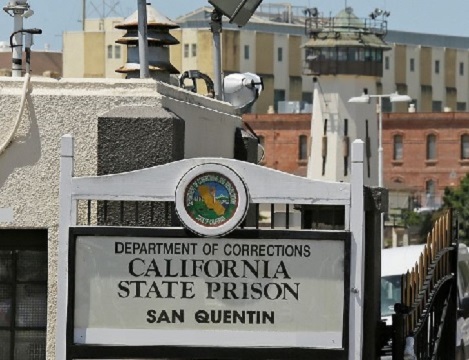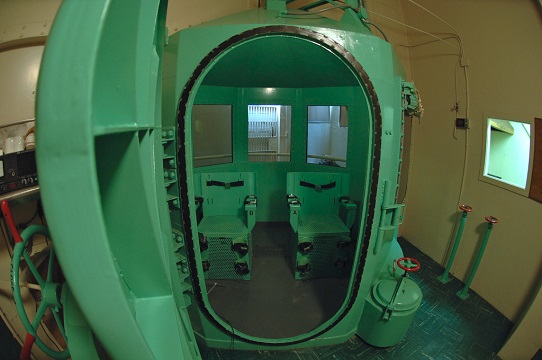
California is transferring everyone on death row at San Quentin prison to other places, as it tries to reinvent the state’s most notorious facility as a rehabilitation centre.
Many in this group will now have new freedoms. But they are also asking why they’ve been excluded from the reform – and whether they’ll be safe in new prisons.
Keith Doolin still remembers the day in 2019 when workers came to dismantle one of the United States’ most infamous death chambers.
He was in his cell at San Quentin prison on the north side of San Francisco Bay, watching live footage on television showing an execution chair – where 194 people had been put to death – carried away after more than 80 years of use. The green gas chamber being taken apart was just several hundred feet from where he sat.
A former long-distance truck driver convicted of murder, Doolin has spent nearly 23 hours a day for the last 28 years in a tiny cell. He long worried he would one day be shackled to a mint-green chair and executed.
But in the last few years, California has been moving fast with some plans for prison reform. Governor Gavin Newsom’s decision to deconstruct the death chamber – and also place a moratorium on the death penalty in the state – was a watershed moment for Doolin.
“He [Newsom] was sending the message: ‘Look, it might take a while, but things are going to change’.”
Mr Newsom is now seeking more changes at San Quentin, which currently has the nation’s largest death row. The governor announced last year that he planned to transform the state’s oldest prison into a rehabilitation centre.
He will close the prison’s death row unit and move Doolin and the other 532 death row inhabitants to standard prisons across the state in the coming months (70 have been moved already).
Doolin and his neighbours will still have death sentences – meaning they will spend the rest of their lives in prison. For some, the threat of execution still looms large, as a future governor could reinstate the state’s death penalty.
Six people on death row who spoke to the BBC over the phone shared mixed feelings about their move. Some were elated by the opportunity to live closer to family and step outside their cells without handcuffs, while others were terrified at the prospect of starting over after decades living alone in a cell.

Rats, birds and handcuffs: Life on death row
Built in 1852, San Quentin is California’s oldest prison and the state’s only facility for incarcerated males who have been sentenced to death. Since 1893, 422 people have been executed there, including by gas, hanging or lethal injection.
Family members walk by the entrance to the prison’s execution chamber every time they visit their loved ones, said Doolin’s mother, Donna Larsen, who drives a nine-hour round trip once a month to visit her son.
The execution chamber would emit a green light that turned red as a person was being executed, a sight visible to Californians driving by on the highway, she said. This green room of death – and infamous incarcerated people such as cult leader Charles Manson – have brought international notoriety to San Quentin, featured in podcasts, television shows and films.
When Ramon Rogers arrived at the prison in 1996, rain leaked through the ceiling of the death row unit, and mice and rats would run rampant. But the biggest pests, he said, were the birds.
“They started defecating all over the place – all over the railings,” he said. “It was a gross environment.”
Since then, life on death row has remained restrictive and, at times, hazardous.
An outbreak of Covid-19 during the height of the pandemic killed at least 12 people on death row – part of a wider coronavirus surge at the prison that infected 75% of the population.
Ms Larsen – Doolin’s mother – said she was shocked by how dirty the prison was the first time she visited.
“It had a stench to it,” she said. “Sometimes Keith’s clothing smells mouldy when we visit. To know that your loved one is living in that made me sick.”
People housed in San Quentin’s death row are kept alone for most of the day in a roughly four foot (1.2m) by nine foot (2.7m) cell, a space that Doolin said feels like a “sardine can”.
The 51-year-old was sentenced to death in 1996 for murdering two sex workers, Inez Espinoza and Peggy Tucker, and shooting four others. In 2009, the California Supreme Court upheld Doolin’s death sentence based on testimony from the surviving victims, who identified him as their attacker.
He has maintained his innocence, and a California attorney has alleged that he has information – learned during another case – that could potentially support his defence. But the lawyer, David Mugridge, told the BBC that he could not share the details due to attorney-client privilege.
Doolin and others living on death row are required to wear handcuffs at all times when outside their cells, which officers have to unlock with metal keys after strip-searching them.

“Our daily life confinement is based on going from one box to another,” said another death row inhabitant, Tony, who declined to share his last name for privacy reasons.
People on death row are offered little access to rehabilitative programmes except for some college courses and jobs such as cleaning showers.
Ending death row
In March 2019, Governor Newsom issued an executive order that halted the death penalty in the state and ordered the dismantling of the gas chamber in San Quentin.
Mr Newsom’s move did not alter any incarcerated individuals’ sentences, though he said that he might later consider commuting death row sentences.
According to the Death Penalty Information Center, black people comprise 34% of California’s death row, but only 6% of the state’s population.
Since 1973, seven people on death row in the state have been exonerated.
Preparing for bigger changes, Mr Newsom announced a two-year pilot programme in 2020 to transfer around 100 volunteers from San Quentin’s death row to other prisons, the first move in his bigger plan to eventually move all the death row inhabitants out, to more than 20 other prisons that meet security requirements.
Correll Thomas left San Quentin with the pilot programme in 2021 after being on death row since 1999.
But at Centinela prison, in Imperial, California, settling in was a struggle. “They didn’t want to give us [rehabilitation] programs,” he said. “We had to pretty much fight for everything.”

Other prisoners and staff appeared frightened of his death row status, said Thomas, who added that with time, some at the prison grew to accept him.
Ramon Rogers, the incarcerated person who first arrived at San Quentin in 1986 when birds and rats had overrun the facility, said the move was welcome.
“I didn’t care where they sent me, I just knew anywhere else would be better,” he said.
Now at the Richard Donovan Correctional Facility in San Diego, Rogers, 64, has been able to enrol not just in rehabilitation programmes but also college.
The greatest relief, he said, came from not having to wear handcuffs around the clock outside his cell for the first time in decades.
“Sometimes, I’m amazed at what I’m allowed to do here that I would never be able to do on death row.”
Starting over
But some advocates say not enough support is being offered as these people on death row make a drastic transition. There is a “huge difference” between the people on death row who chose to leave and those being forced to move now, said Gavrilah Wells, a volunteer with human rights group Amnesty International.
“I’m so worried about the safety and the human rights of so many people being involuntarily transferred,” she said. “The massive endeavour of rapidly moving 550 people to unknown prisons, with unknown cultures specific to each facility, raises serious concerns.”
Ms Wells and other advocates say moving the death row population, which includes many who are sick and elderly, poses great challenges. The oldest person in San Quentin’s death row is 93.
“It’s not the same as just transferring any person in prison,” said Natasha Minsker, a policy adviser for non-profit Smart Justice California.
Advocates worry about those being moved far away from their lawyers and family members, and how they will adjust after decades living alone in a cell.
“These guys have never lived with anyone but themselves,” Tony said. “They’re going to have to learn how to do things all over again.”
Doolin is anxious about avoiding conflict as he interacts with more people than ever before, including prison guards.
“It’s extremely stressful,” he said. “I’m forced to start all over again like my first day in prison.”
Ms Larsen, Doolin’s mother, said she and others suggested programmes to offer support to their incarcerated loved ones as they made the transition, but the prison turned them down.
‘We still have humanity’
For several death row inhabitants, the anxieties of a new environment are outweighed by the prospect of breaking free from a dismal life in San Quentin.
“For some people, it’s a godsend,” Tony said. “They want to leave this oppression.”
But for others, the departure from San Quentin before its estimated $360m (£282m) upgrade has served as a reminder of how those on death row are treated differently to other prisoners. Mr Newsom has said the goal is to transform the prison into a college campus-like setting, modelled on Scandinavian correctional facilities that focus on rehabilitation.
In response to a question from the BBC on how people on death row fit into the state’s larger plans for prison reform, Mr Newsom’s office said he was committed to “addressing failings in our criminal justice system – including the discriminatory nature of the death penalty system”.
Mr Newsom’s office did not elaborate on why people on death row could not participate in the San Quentin project, but touted the closure of death row and his moratorium on the death penalty.
The California Department of Corrections and Rehabilitation said all who were incarcerated on death row had to be moved because San Quentin did not have the “required lethal electrified fence”. It did not respond when asked why that had been okay up to this point. It also did not respond to questions about support being offered to transfers.
Darrell Lomax, one of the men in San Quentin, said: “It’s not what they’re doing. It’s the way they’re doing it… Why are we being moved so they can make room for a rehabilitation program that doesn’t even serve us?”
The arrangement sends the “unfortunate” message that one of the biggest prison reform projects in the US can’t include people sentenced to death, Ms Minsker said.
Tony believes some in California are still not ready to reckon with the status – and future – of those sentenced to death, even in a state that is not executing people.
“There’s a notion that because we’re here, it’s the end of the road,” he said. “But we still have humanity in this place. I don’t think our humanity has been seen enough.”
Source: bbc.co.uk







Be the first to comment